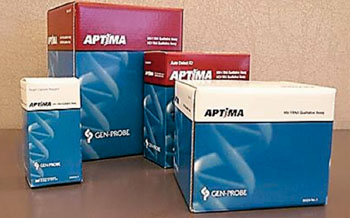Earliest Stage of Human Immunodeficiency Virus Infection Analyzed
By LabMedica International staff writers
Posted on 29 Jun 2016
The first days after Human Immunodeficiency Virus infection are very important because sexual partners are exposed to extremely high risks of infection due to the subsequent high viral load in the infected person.Posted on 29 Jun 2016
This period of time determines the further course of HIV infection as acute human immunodeficiency virus type 1 (HIV-1) infection is a major contributor to transmission of HIV-1. An understanding of acute HIV-1 infection may be important in the development of treatment strategies to eradicate HIV-1 or achieve a functional cure.

Image: The Aptima HIV-1 RNA qualitative assay (Photo courtesy of Hologic).
A large team of scientists led by specialists at the Medical Center of the University of Munich (Germany) performed twice-weekly qualitative plasma HIV-1 ribonucleic acid (RNA) testing in 2,276 volunteers who were at high risk for HIV-1 infection. For participants in whom acute HIV-1 infection was detected, clinical observations, quantitative measurements of plasma HIV-1 RNA levels (to assess viremia) and HIV antibodies, and results of immunophenotyping of lymphocytes were obtained twice weekly. The study participants were from Tanzania, Kenya, Uganda and Thailand.
The investigators used a specific, highly sensitive method called APTIMA (Hologic, Bedford, MA, USA), which is able to detect very low concentrations of around 20 copies of HIV RNA/mL of plasma, to detect newly acquired HIV infections. By means of this method, a total of 112 people were confirmed positive only a few days after HIV infection. These very early-stage cases of HIV infection had an average of five days between the last negative and the first positive blood test. Analyzing cases at such early stages of infection has been unique up to now, because earlier studies only included patients who already had symptoms or had contracted the infection several weeks earlier.
The period of time between the first confirmation of HIV-RNA and peak viremia lasted an average of 13 days. On the other hand, the so-called viral-load set point, meaning the period of time between the highest and lowest values, was 31 days. For HIV patients, the further course of disease is determined by the set point because viral load values remain constant over a long period of time after this. The level of viremia at this point in time determines whether the course of HIV infection will be rapid or slow. Clinical manifestations of acute HIV-1 infection were most common just before and at the time of peak viremia.
The authors concluded that the viral-load set point occurred at a median of 31 days after the first detection of plasma viremia and correlated with peak viremia. Few symptoms and signs were observed during acute HIV-1 infection, and they were most common before peak viremia. Arne Kroidl, MD, who is responsible for clinical HIV studies, said, “Long-term goals of these investigations, which we are also conducting with a German cohort at the Department of Infectious Diseases and Tropical Medicine (DZIF), is to develop strategies to eradicate HIV from the body and to achieve long-term HIV remission, and possibly even a cure.” The study was published on June 2, 2016, in the New England Journal of Medicine.
Related Links:
Medical Center of the University of Munich
Hologic














